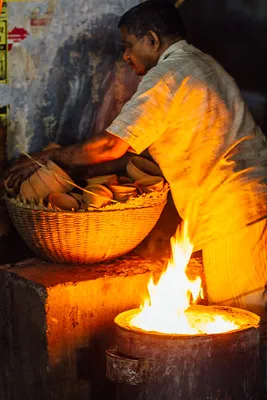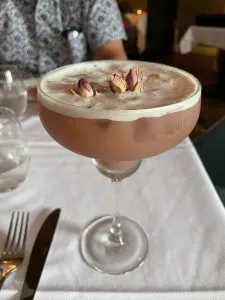
When I moved to India in 2007, I knew almost nothing about Indian food. My late dad was many wonderful things, but curious about food was not one of them, and our house was pretty meat-and-potatoes.
Going to college in New York City had been an unmatched opportunity to eat food from all over the world and branch way, way out from the dishes of my childhood—which I did as often as I could.
But like most students, I didn’t have a lot of money, so I didn’t eat out a lot. I usually ate in the dining hall or cooked in my dorm. There were occasional experiments, but I tended to make dishes I already knew how to prepare competently. In my early post-college years, I worked a ton of overtime at my job at the Metropolitan Museum of Art, and spent my very limited grocery budget mostly on oatmeal, PBJs, ingredients for tuna salad, and variations on rice and beans. Boring, I know, but it worked at the time. Some nights I cooked with my Dominican roommate (she made excellent food!) or went to a 24-hour diner with coworkers also on the night shift.

All that changed when I arrived in New Delhi. I was still working long hours, but I had more disposable income and more free time. There were just so many wonderful options everywhere I turned. At work, the canteen hot lunch was OK in a pinch, but far more interesting were tiffin subscriptions—you’d get a home-cooked thali-style lunch of rice, beans, vegetables, etc. delivered to the office. And if you wanted to go out, a narrow street next to our office complex was a constantly changing buffet of deliciousness. In the mornings, vendors served spicy, sweet chai boiled in massive pots, puffy kochuri, and flaky cauliflower parantha dripping with ghee and accompanied by sour pickle. Afternoons meant chaat, biryani, and thalis. The evenings were my favourite—I almost always got a hot, enormous naan from a metal-barrel tandoor. My friends and I would laugh and talk as we ate by the light of the oven’s flames.
Weekends meant restaurant meals at hip New Delhi restaurants of a type that had just been out of my reach in New York, where I would share Punjabi classics with friends. Or afternoons exploring the narrow streets of Old Delhi, where I tasted sweet, crunchy jalebi, succulent tandoor chicken, and even brain curry. In the summer, there were flavoured shaved ices and kulfi, a frozen dessert made with condensed milk. On weekend trips with friends around northern India, we would enjoy hearty dishes like dal makhani (black lentils cooked with butter and cream) at dhabas, casual roadside restaurants. At home, our cleaning lady taught me how to make roti and my vegetarian roommate showed me how to prepare rajma chawal (kidney beans in a flavourful gravy) and karela (bitter gourd).
Today I want to share with you five flavors that instantly take me back to India: fenugreek, rose, tamarind, mango, and mustard. Of course, these ingredients and the flavours they impart are used in many cuisines around the world. But I first fell in love with them in India.
Fenugreek: A Bittersweet Complexity
Fenugreek, or methi as it’s called in India, carries a reputation both as a humble herb and a powerful healer. Native to the Mediterranean region and, according to some sources, western Asia, fenugreek seeds found their way to Indian kitchens through ancient trade routes. Today, India is a major producer of the plant and fenugreek is used in regional dishes across the subcontinent.
I love bitter flavours, but acknowledge that at first taste, fenugreek’s bitterness can be jarring. However, this quality reveals deeper layers when handled with care. When used in small quantities, especially in spice blends like panch phoron (“five-spice”) in Bengal or as a crucial ingredient in sambhar powder in South India, fenugreek imparts a subtle, nutty warmth that balances more pungent spices.
Fenugreek leaves, whether fresh or dried (kasuri methi), introduce an earthy sweetness when added to curries and lentils, transforming dishes like methi aloo (potato with fenugreek) into something that’s way more than the sum of its parts. While living in India, I always had a bag of Haldiram’s methi mathri (a kind of flaky, savoury hard biscuit) on hand. My current go-to way to enjoy this flavour is the fenugreek chicken, with loads of fresh leaves, at Guru Curry House down the block from my apartment in Oakland.
Fun fact: the plant’s name Trigonella foenum-graecum means “Greek hay.”
Rose: A Fragrant Elegance
If fenugreek represents the grounding earth, rose is surely the ethereal sky. Ancient Ayurvedic texts mention rosewater distillation, and the first-century CE text the Charak Samhita mentions many uses. Traveller accounts from ancient times up through the 1500s CE note the love of roses in kingdoms throughout modern-day India.

The history is very murky, as far as I can tell, but the Persians appear to have perfected the distillation process. It was perhaps during the Mughal era (1526–1857), a period marked by Persian influence on Indian culture, that rose became a popular flavouring in food. Mughals, known to be lovers of beauty and luxury, enjoyed elegant desserts that may have had Persian and Turkish roots.
Today, rose is still often associated with sweet dishes. Its delicate aroma elevate desserts like the very popular gulab jamun (milk-solid dumplings in rose-scented syrup) and falooda (a fragrant milk-based dessert with noodles and basil seeds). The one I like best is ras malai, a dessert from Bengal that we will surely get to taste on the tour. It’s made from chhena, a kind of acid-set cheese, soaked in clotted cream; the milk solids are cooked in rosewater and flavoured with saffron and pistachio.
In savory dishes, rose petals are sometimes ground into spice blends, where they soften the intensity of fiery chilies and aromatic cloves, adding a floral counterpoint to heavy flavors. The Times of India recommends making a rose petal chutney or adding rosewater when preparing biryani.
And it’s great in cocktails! My rose-scented whisky sour was a highlight of a meal with Worldwide Quest’s own Laurielle Penny.
Tamarind: Tangy Depths
If one flavor could encapsulate the complexity of Indian cuisine, it might just be tamarind. Its tangy, slightly sweet and sour profile captures the balance of flavours that Indian dishes often strive for. Tamarind trees are native to tropical Africa, but they became an integral part of Indian culinary culture centuries ago. Like fenugreek, the tamarind is part of the pea family.
In southern and western India, tamarind is the backbone of many dishes. Think of the iconic sambhar or rasam, where tamarind pulp provides a sour foundation for spices like cumin, mustard seeds, and black pepper. You may have had sambhar alongside a dosa or a serving of idli (rice dumplings).
My Sunday evening ritual in New Delhi was to go to a shopping centre that housed a South Indian restaurant I loved. I’d do my grocery shopping, run errands at the drugstore, then have a dosa. I’d always get a big order of tamarind rice topped with peanuts to go. This tangy rice was just so good. I’ve tried to replicate it but it’s never quite the same, alas.
In North India, tamarind’s tanginess features prominently in imli chutney, a sweet-sour sauce served with snacks like samosas and chaat that you find at many an Indian restaurant in North America—including my favourite place in Toronto, The Host. Tamarind also plays a crucial role in beverages like panna, a refreshing summer drink made with raw mangoes and spices.
Mango: The King of Fruits
For many in India, mango is the epitome of summer, a fruit so beloved it’s often called the “king of fruits.” As April approached, my colleague Nikhil would talk about all the alphonso mangoes he was going to eat. Their flavour is just so purely mango. I also liked the super-sweet chaunsa. Our team members in New Delhi each had their own favourite variety of mango, and would debate fiercely over the quality of this year’s crop compared to last.
In Indian cuisine, mango is celebrated in both its raw and ripe forms, each bringing its own flavors and uses. Mangoes have been cultivated in India for over 4,000 years, and they appear in everything from traditional meals to poetry, symbolizing abundance, love, and the ephemeral nature of life.
Raw mango, or kaccha aam, with its sharp sourness, is a key ingredient in aam ka achar (mango pickle), a pantry staple in many Indian households. I love it as a side to parantha or added inside a grilled cheese sandwich. Give it a try, the sharp pickle and the cheesy, buttery sandwich are a great combo.
Meanwhile, ripe mangoes, juicy and fragrant, find their way into desserts like aam ras (a mango pulp dish) and the world-famous mango lassi. One of my favourite places to enjoy all things mango was Lodi, a restaurant in the relaxing Lodhi Gardens. On a summer Sunday, there was no better place to be than enjoying a mango cocktail on the tree-shaded patio.
Mustard: A Fiery Foundation
Mustard is the silent hero of Indian cuisine, particularly in Bengal, where mustard oil and seeds feature prominently in many dishes.
The brown mustard plant (Brassica juncea) is thought to have originated in the Himalayas, and the use of mustard goes back to earliest recorded history. Mustard seeds are often the first ingredient to hit the hot oil in a traditional Indian tempering process, known as tadka. The resulting crackle releases an unmistakable pungency, infusing the dish with a warmth that is as comforting as it is bold.
In Bengali cuisine, mustard seeds are ground into a paste to create the famous shorshe bata, used to flavor fish curries. Mustard oil lends a sharp bite to vegetable dishes like aloo posto (potatoes with poppy seeds). Its bright, pungent heat is also mellowed in pickles, where mustard seeds act as both flavor enhancers and preservatives.
I’m a mustard lover, and the chance to taste it in so many dishes was one of the highlights of visiting Kolkata for me. My hands-down favourite is bhetki macher paturi, fish fillet in mustard paste, wrapped in banana leaves. I had it at the old standby Kewpies, but friends tell me there are terrific newer places for our tour group to try.
Which Flavours Will Define India for You?
The flavors of fenugreek, rose, tamarind, mango, and mustard tell stories of cultural exchange, royal indulgence, and humble tradition. They are just a few of the many flavours and ingredients that make Indian cuisine so diverse and just plain delicious. For me they conjure up many happy memories in India: cooking with friends, enjoying swanky cocktails, or sharing meals with my sister Carolyn, who travelled with me across the subcontinent on an epic vacation.
Which dishes and flavours will be part of your Indian experience? Whatever you crave, India will have it. And if you’re worried about spiciness, don’t be. With their 50 years of experience of taking travellers to India, Worldwide Quest has a network of guides and tour managers who are focused on your comfort. We’ll make sure your meals align with your tastes.
Join me for culinary and cultural adventures in November 2025 for our Ganges River Cruise tour. I can’t wait to welcome you in India!
Image credits: Night market in Varanasi, Adam Cohn on Flickr
Sources: Food Origins: Ep 3 — From Royal Treat to Street Sweet: Gulab Jamun; Tracing the Colonial History of Roses
